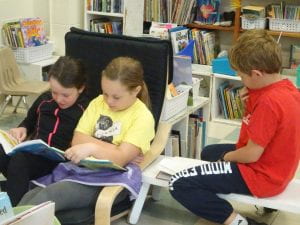 It’s been a busy weeks. The math stations seem to be working well, blogging continues to be exciting – thank you for all the comments and for sharing the blogging address so widely, and we’ve begun our second set of book clubs which is great, great, great.
It’s been a busy weeks. The math stations seem to be working well, blogging continues to be exciting – thank you for all the comments and for sharing the blogging address so widely, and we’ve begun our second set of book clubs which is great, great, great.
Humphrey Book Clubs
Humphrey always says things in three’s when he’s excited. We’re having fun reading books from this series together. We’re reading five different books in the series and learning how to record our understanding each time we read. We’re learning to use the Essence Strategy. That is recording the main idea or what we feel is essential in each chapter. When we share what we’ve recorded with each other we also try to share how and why we made those inferences.
S.E.L. – Open Circle – Considering the Impact of Our Words
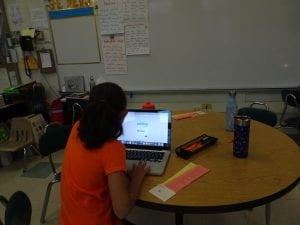 This week our S.E.L. discussions have focused on the definition of bullying and how we can take care with our words. We’ve practiced being encouraging, complimentary and caring. We’ve talked about reading reactions and apologizing. We’ve read several different books, Say Something, Just Kidding, Red, and Poetreeto help us imagine different situations and to remind us of things that happen around us each day that we might make better. We’ve discussed advocating for our selves and others. We’ve begun to explore what it means to be an up-stander.
This week our S.E.L. discussions have focused on the definition of bullying and how we can take care with our words. We’ve practiced being encouraging, complimentary and caring. We’ve talked about reading reactions and apologizing. We’ve read several different books, Say Something, Just Kidding, Red, and Poetreeto help us imagine different situations and to remind us of things that happen around us each day that we might make better. We’ve discussed advocating for our selves and others. We’ve begun to explore what it means to be an up-stander.
Learning the Commutative and Distributive Property of Multiplication
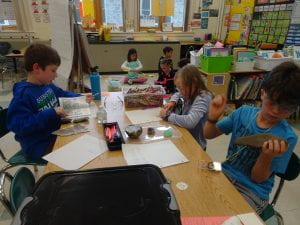 Our goal in daily problem solving is to offer the children opportunities to practice logical thinking and to find ways to use new knowledge to become more efficient over time. The children choose a strategy they can use to document their thinking and follow through to an accurate solution. This can be challenging. When you and I read the problems, we see that most of them can be solved with multiplication, but because it is still new to your children, it is not always their choice.
Our goal in daily problem solving is to offer the children opportunities to practice logical thinking and to find ways to use new knowledge to become more efficient over time. The children choose a strategy they can use to document their thinking and follow through to an accurate solution. This can be challenging. When you and I read the problems, we see that most of them can be solved with multiplication, but because it is still new to your children, it is not always their choice.
Please expect this. There are many things happening all at once in this thinking process. The children have to read the problem and visualize the operations that are happening in the story. The problems generally have two-steps, sometimes more, and often more than one operation. They have to keep them separate which is not always easy. The problems also use amounts that are manageable, but still challenging.
At this point you’ll notice any range of strategies. Sometime the children are drawing out the problems. This can become cumbersome and mistakes are often made when counting. Sometimes children are skip counting or using a doubling strategy. Sometimes children are able to mentally manipulate amounts in their minds but are off by a bit when the value of a digit is confused. Each child is using what s/he knows to solve the problem, and with time will become more efficient. With time you’ll see changes and progress. The children selected sample problems in the classroom to anchor their understanding and process at this time. You may want to save some at home too, so you can talk about the growth that you see when you look at problems from across the year. They’ll be surprised that you notice how they are using more sophisticated strategies and understanding all four operations with whole numbers and fractions.
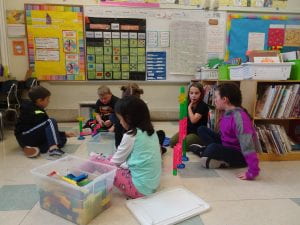 We’ve spent some time understanding the ARRAY model of multiplication. The class has learned about the commutative property. We are sure that 6×7=7×6 even if we are not instantly sure of the answer. On top of that we can create an array of that amount and find a way to solve it (We know how to 7 fives and then we just need to add one more on. Or we could double 6 three times and add one more.) It is interesting to discover there are many correct ways to reach a solution.
We’ve spent some time understanding the ARRAY model of multiplication. The class has learned about the commutative property. We are sure that 6×7=7×6 even if we are not instantly sure of the answer. On top of that we can create an array of that amount and find a way to solve it (We know how to 7 fives and then we just need to add one more on. Or we could double 6 three times and add one more.) It is interesting to discover there are many correct ways to reach a solution.
We’ve also been learning how to use what we know about place value to help us multiply larger amounts. We’ve just begun to explore the distributive property. At this point taking these steps more often help us with accuracy. They remind us to multiply everything – not just the hundreds and tens, but also the ones.
The problems have been written to help the children practice using this skill to become more efficient. More and more of the children are feeling sure of themselves with this strategy.
Bits and Pieces –
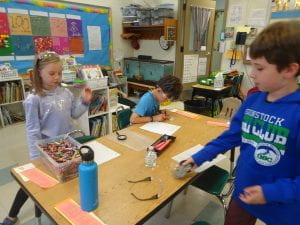 We are still trying to find out why Mrs. Brisbane is away from here class in Room 26. Humphrey’s been collecting clues and we have too. We’re having fun reading Mysteries According to Humphrey.
We are still trying to find out why Mrs. Brisbane is away from here class in Room 26. Humphrey’s been collecting clues and we have too. We’re having fun reading Mysteries According to Humphrey.- We’ve been reading about different types of scientists and science. The children have been thinking about science topics they might like to explore. They’ve considered things from nature they might like to observe, things about space or space exploration they might want to know more about, or insects or rocks… They’ve been thinking about what they have lots of questions about so we can begin an independent inquiry project.
- A reminder – Parent-Teacher conferences are coming up next week on Tuesday, Thursday and Friday.

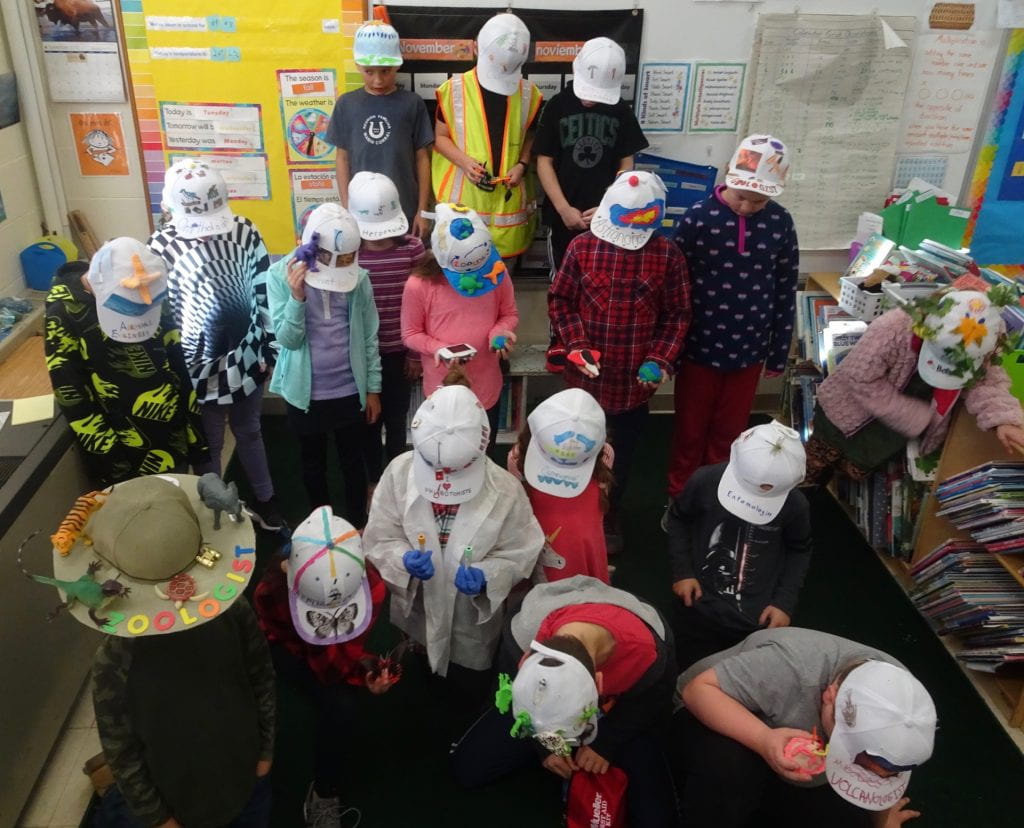 We had a wonderful day celebrating scientists and science today. First of all, thank you for your time and support of this project. The children love science! They have an open, questioning mind about the subject and an understanding of how diverse it is because of this project. The children know that “mad scientists” are fiction and, they have a strong sense of what scientists do to solve problems and to continually ask questions to lead to further discoveries. They know that one question, leads to another, and another after that.
We had a wonderful day celebrating scientists and science today. First of all, thank you for your time and support of this project. The children love science! They have an open, questioning mind about the subject and an understanding of how diverse it is because of this project. The children know that “mad scientists” are fiction and, they have a strong sense of what scientists do to solve problems and to continually ask questions to lead to further discoveries. They know that one question, leads to another, and another after that.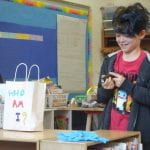
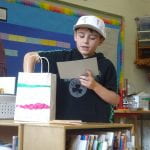
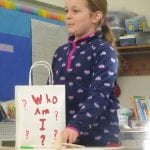

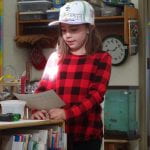
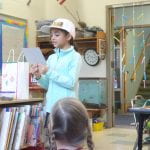

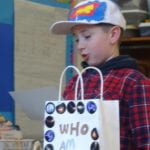
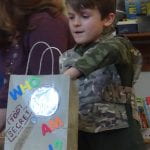
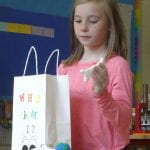



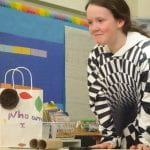

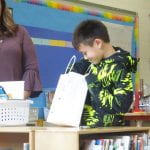
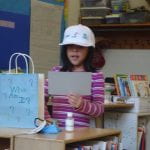
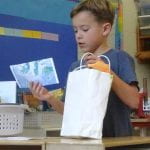
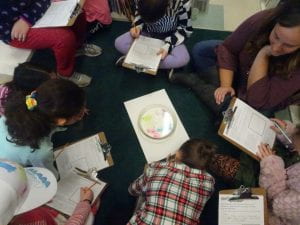


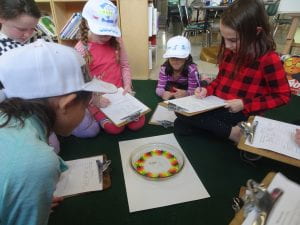
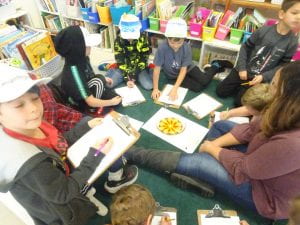
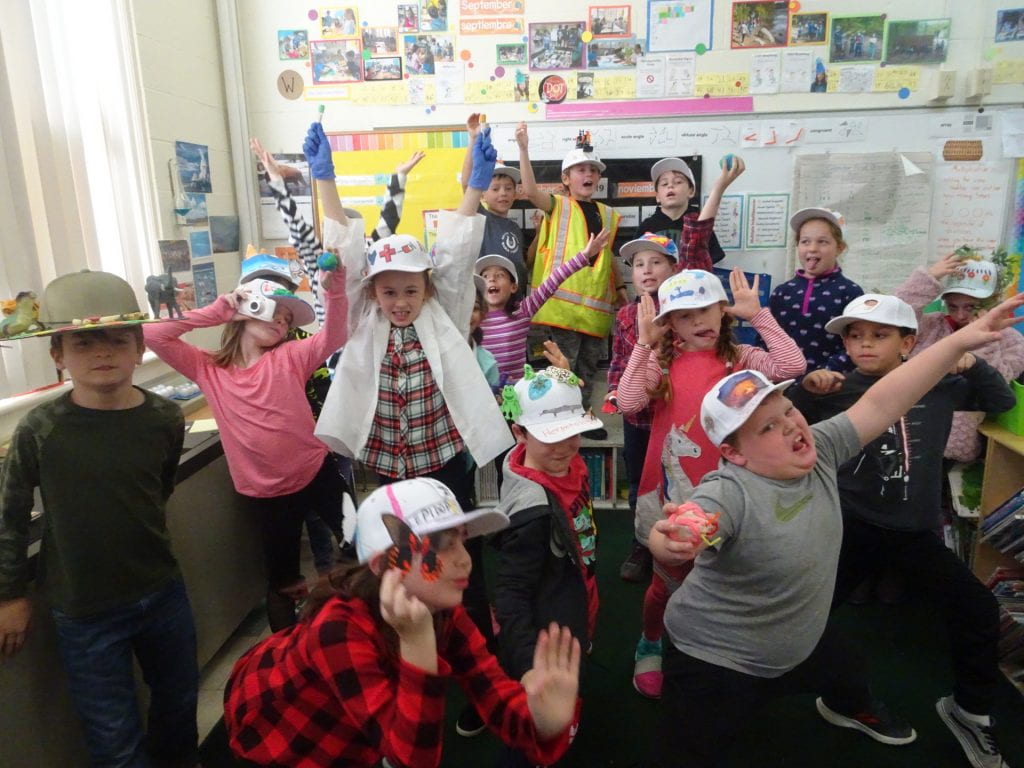
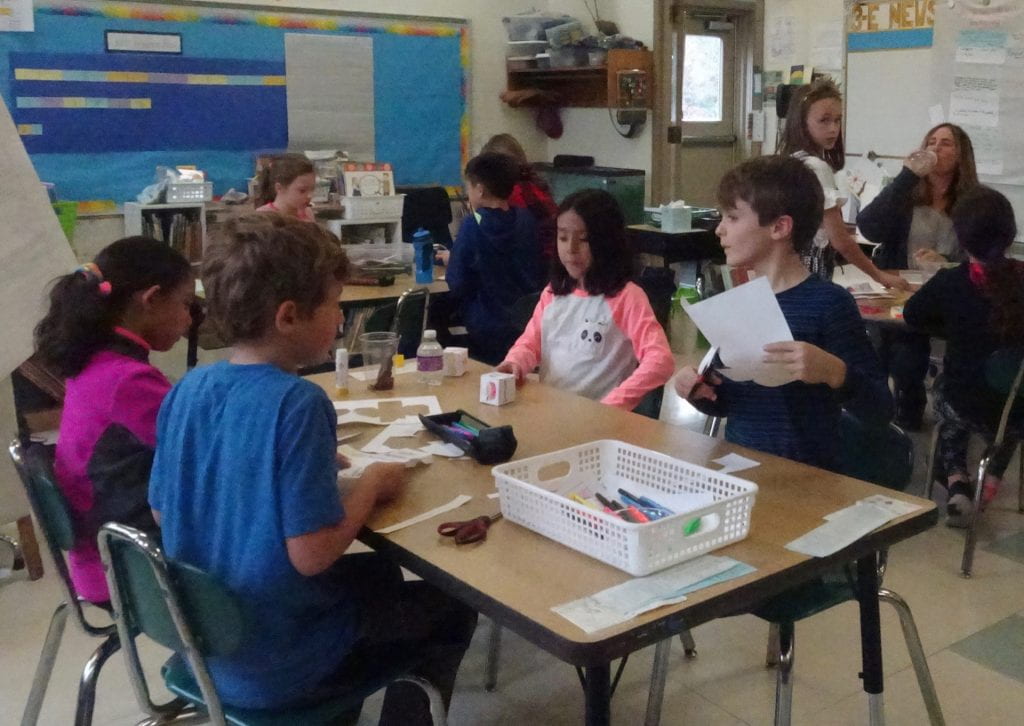
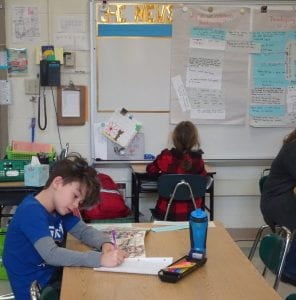 Each of the children has chosen an individual inquiry topic to research. They began by asking questions to guide their research. They’ve been exploring books and online resources as well. Some of these sources can be accessed through the school library and others can be accessed through the “Research Resources” category side bar on our blog. We are working to make sure we write our own original thoughts so we’ll be able to share our own understanding as we write and create. The children are reading a page or a section, putting the book aside, and writing a note about what they think the author was trying to teach them. It slows the research process down and helps the children think closely about what they know and understand. Several of them have finished their research and are beginning to create their writing and planning their displays.
Each of the children has chosen an individual inquiry topic to research. They began by asking questions to guide their research. They’ve been exploring books and online resources as well. Some of these sources can be accessed through the school library and others can be accessed through the “Research Resources” category side bar on our blog. We are working to make sure we write our own original thoughts so we’ll be able to share our own understanding as we write and create. The children are reading a page or a section, putting the book aside, and writing a note about what they think the author was trying to teach them. It slows the research process down and helps the children think closely about what they know and understand. Several of them have finished their research and are beginning to create their writing and planning their displays.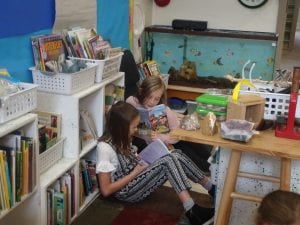 We are continuing to develop comprehension strategies in our book clubs. Our first book club choices were centered on the idea that everyone can write what they know and feel in their hearts. All of the books in the first book club picture books. The clubs were designed so that everyone could meet the expectations of 1) completing the book, 2) writing a summary, 3) selecting a favorite part to speak to and 4) to make an inference about the author’s message. All of the children met these expectations and had we some great discussions about their books and reading.
We are continuing to develop comprehension strategies in our book clubs. Our first book club choices were centered on the idea that everyone can write what they know and feel in their hearts. All of the books in the first book club picture books. The clubs were designed so that everyone could meet the expectations of 1) completing the book, 2) writing a summary, 3) selecting a favorite part to speak to and 4) to make an inference about the author’s message. All of the children met these expectations and had we some great discussions about their books and reading.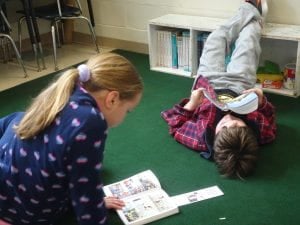 Our second book clubs selections have been all about Humphrey. We have enjoyed getting to know this character, along with more about the students in Room 26. The children have been using the Essence or the Line-A-Page strategy to keep track of the thinking as they read. We are close to the end of the books with 1, 2 or 3 chapters remaining. Some of the readers are expressing fatigue – it takes too long to write it all out – and yet they are learning that the strategies do help them then and understand. We hope to be done in early December.
Our second book clubs selections have been all about Humphrey. We have enjoyed getting to know this character, along with more about the students in Room 26. The children have been using the Essence or the Line-A-Page strategy to keep track of the thinking as they read. We are close to the end of the books with 1, 2 or 3 chapters remaining. Some of the readers are expressing fatigue – it takes too long to write it all out – and yet they are learning that the strategies do help them then and understand. We hope to be done in early December. This week we began a study of estimation. We hope to answer these questions: What is an estimate? Why do people estimate? When could we use estimation? Can we find examples where estimation is used outside of school?
This week we began a study of estimation. We hope to answer these questions: What is an estimate? Why do people estimate? When could we use estimation? Can we find examples where estimation is used outside of school? We are continuing to explore
We are continuing to explore 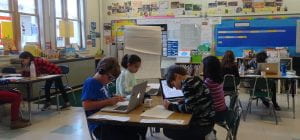 We’re reading
We’re reading 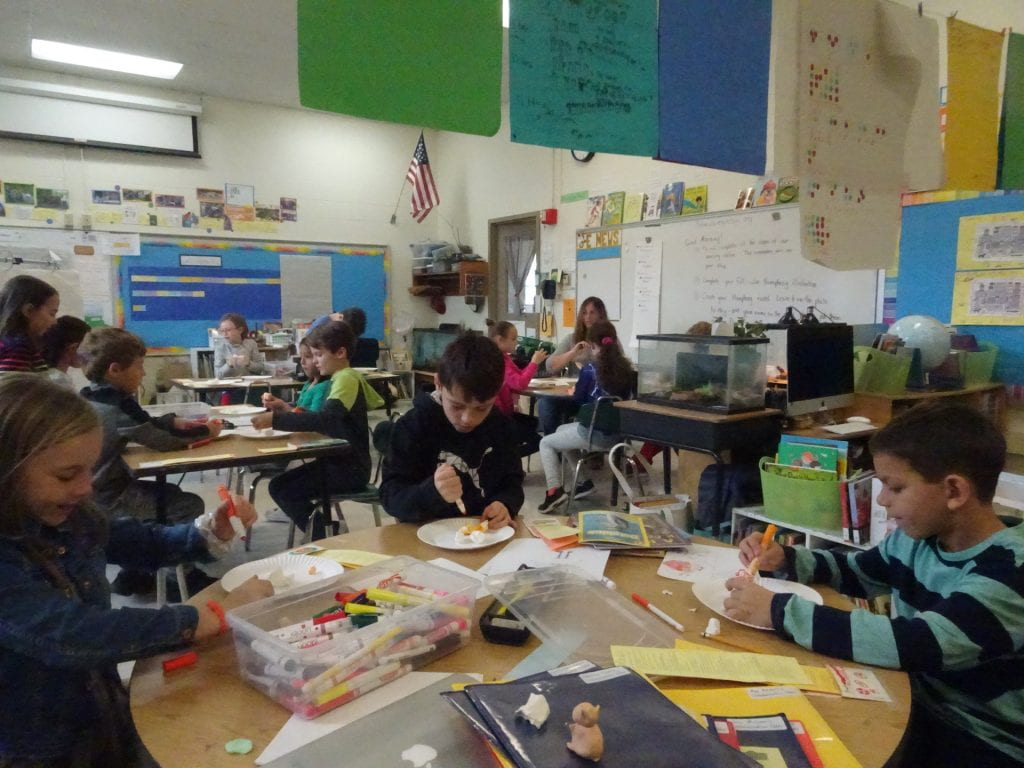 We’ve been thinking about gratitude and learning some of the history behind Thanksgiving. We finished our second Humphrey read-aloud and the Humphrey book clubs are starting to wrap up as well. We had fun creating Humphrey models and Humphrey art this week. We had a couple indoor recesses and so many in the class had the chance to build with marble works and explore magnetism – a great introduction to our next science inquiry, force and motion.
We’ve been thinking about gratitude and learning some of the history behind Thanksgiving. We finished our second Humphrey read-aloud and the Humphrey book clubs are starting to wrap up as well. We had fun creating Humphrey models and Humphrey art this week. We had a couple indoor recesses and so many in the class had the chance to build with marble works and explore magnetism – a great introduction to our next science inquiry, force and motion. We’ve spent some time learning about note taking, research and informational writing. The children have each chosen a topic to research ranging from dingoes and red pandas to Apollo 11 and galaxies. They’ve been researching in the library and online. You may want to talk to your child about the topic he or she has chosen to find out what they have discovered so far. Often talking helps uncover new questions, or will connect them to new resources and information. This independent inquiry, combined with the Who Am I? project and other classroom experiences with observation, description and guided experiments has been designed to help the children understand the nature and variety of scientific exploration. (And it’s fun.)
We’ve spent some time learning about note taking, research and informational writing. The children have each chosen a topic to research ranging from dingoes and red pandas to Apollo 11 and galaxies. They’ve been researching in the library and online. You may want to talk to your child about the topic he or she has chosen to find out what they have discovered so far. Often talking helps uncover new questions, or will connect them to new resources and information. This independent inquiry, combined with the Who Am I? project and other classroom experiences with observation, description and guided experiments has been designed to help the children understand the nature and variety of scientific exploration. (And it’s fun.)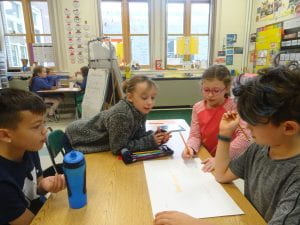 This week we’ve spent some time reading about Thanksgiving. We’ve learned some about the Pilgrims and some about New Hampshire’s role in helping Thanksgiving become a national holiday. See if you child can tell you about it. We’ve spent time considering how gratitude can help us notice how fortunate we are. Your children created a top 10 list and worked to create an acrostic poem for their blog.
This week we’ve spent some time reading about Thanksgiving. We’ve learned some about the Pilgrims and some about New Hampshire’s role in helping Thanksgiving become a national holiday. See if you child can tell you about it. We’ve spent time considering how gratitude can help us notice how fortunate we are. Your children created a top 10 list and worked to create an acrostic poem for their blog. As I prepare the first term report cards, I’d like to thank so many of you for coming to your child’s goal setting conference to hear how he or she describes his/her learning process at this point in the year. It is challenging for eight and nine year olds to reflect on learning. They each spent time to thoughtfully identify strengths and to look for areas of growth. Each of the children did a wonderful job with this process and in choosing the work to serve as evidence for their claims. Thank you, also for meeting with me to share assessment data and work samples that will help you (hopefully) better understand the report cards when you receive them.
As I prepare the first term report cards, I’d like to thank so many of you for coming to your child’s goal setting conference to hear how he or she describes his/her learning process at this point in the year. It is challenging for eight and nine year olds to reflect on learning. They each spent time to thoughtfully identify strengths and to look for areas of growth. Each of the children did a wonderful job with this process and in choosing the work to serve as evidence for their claims. Thank you, also for meeting with me to share assessment data and work samples that will help you (hopefully) better understand the report cards when you receive them. Because of our conferences, this term’s report card will not have an extensive narrative comment – those will come with terms two and three. If you find you have questions and concerns, please don’t hesitate to ask. If you’ve not been able to schedule a conference, please let me know if you would like to meet.
Because of our conferences, this term’s report card will not have an extensive narrative comment – those will come with terms two and three. If you find you have questions and concerns, please don’t hesitate to ask. If you’ve not been able to schedule a conference, please let me know if you would like to meet. Finally, it would be greatly appreciated if you could find time to talk with your child about what it means at your house to put forth one’s best effort. Each child understands our classroom discussions differently. For some children, it seems, working fast is best. That means they skim across the activities doing what they already know rather than extending themselves to learn “new”. As a result, expectations are only partially met. For other children it seems as though assignments are secondary, being social comes first. Conversation consumes their time. They approach tasks as if they can get them done eventually. As a result of these choices, expectations are seldom met. The children simply run out of time. Some children lack confidence. They are not sure they’ll succeed, and so not trying feels like a safer option. We’ve been talking about positive self-talk and growth mindset. All of the children need support with organizing, prioritizing and managing time. They will benefit from finding ways to listen to their positive inner voice as they explore ideas and find opportunities for learning in all they do whether simple or complex. Thank you for your help in exploring these ideas with your child. It will be exciting to see how learning grows in 3E.
Finally, it would be greatly appreciated if you could find time to talk with your child about what it means at your house to put forth one’s best effort. Each child understands our classroom discussions differently. For some children, it seems, working fast is best. That means they skim across the activities doing what they already know rather than extending themselves to learn “new”. As a result, expectations are only partially met. For other children it seems as though assignments are secondary, being social comes first. Conversation consumes their time. They approach tasks as if they can get them done eventually. As a result of these choices, expectations are seldom met. The children simply run out of time. Some children lack confidence. They are not sure they’ll succeed, and so not trying feels like a safer option. We’ve been talking about positive self-talk and growth mindset. All of the children need support with organizing, prioritizing and managing time. They will benefit from finding ways to listen to their positive inner voice as they explore ideas and find opportunities for learning in all they do whether simple or complex. Thank you for your help in exploring these ideas with your child. It will be exciting to see how learning grows in 3E.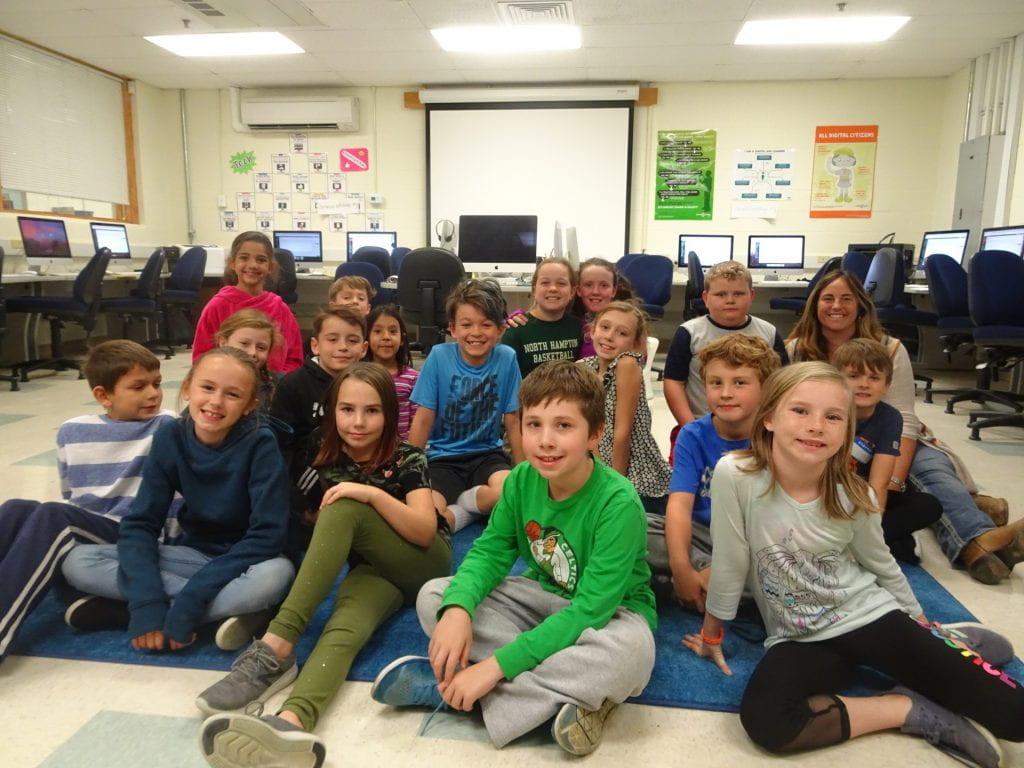 I’ve enjoyed following the student-led goal setting conferences with the parent-teacher conferences this week. Thank you for your time and your interest in how we can work together to create a third grade that feels engaging for each unique member of our learning community.
I’ve enjoyed following the student-led goal setting conferences with the parent-teacher conferences this week. Thank you for your time and your interest in how we can work together to create a third grade that feels engaging for each unique member of our learning community.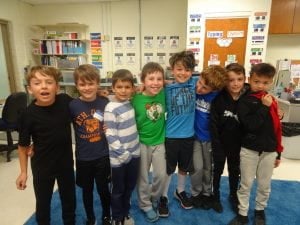 Throughout the week we’ve explore kindness, curiosity, note taking, learning about and using comprehension strategies for reading nonfiction and fiction.
Throughout the week we’ve explore kindness, curiosity, note taking, learning about and using comprehension strategies for reading nonfiction and fiction.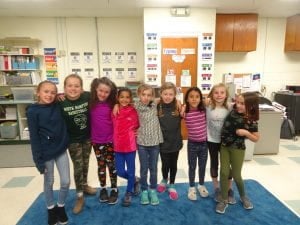 This week we’ve read books and held discussions centered on kindness each day. We’ve explored what it looks like, what it feels like and what it sounds like. We’ve talked about coping with disappointment and dealing with frustration. We’ve talked about how fairness and honesty play a part in kindness. We learned the difference between being a bystander and an up-stander who advocates for others when there is an imbalance of power. We are all trying to live up to our own expectations – it is easy to talk and write about kindness. It is not always easy to act with kindness in the classroom or on the playground but we’ll keep trying and doing all we can to grow.
This week we’ve read books and held discussions centered on kindness each day. We’ve explored what it looks like, what it feels like and what it sounds like. We’ve talked about coping with disappointment and dealing with frustration. We’ve talked about how fairness and honesty play a part in kindness. We learned the difference between being a bystander and an up-stander who advocates for others when there is an imbalance of power. We are all trying to live up to our own expectations – it is easy to talk and write about kindness. It is not always easy to act with kindness in the classroom or on the playground but we’ll keep trying and doing all we can to grow.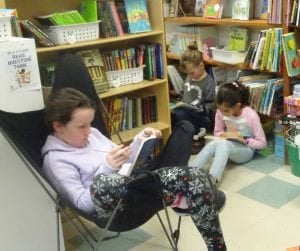 We’ve learned three different strategies for tracking our understanding: Sketch to Stretch, Essence – identifying the main idea, and A Line A Page. One of the things the kids have noticed is that taking time to write slows them down. At first this was a bother, but now most of the children recognize how stopping to think and write truly does help them understand and remember more of what they are reading. We’re having fun with the Humphrey book clubs. Humphrey and Og are inspiring classroom pets. We are looking forward to celebrating the completion of our clubs by making models of Humphrey, writing reviews and creating illustrations of our favorite parts of the books we have been reading.
We’ve learned three different strategies for tracking our understanding: Sketch to Stretch, Essence – identifying the main idea, and A Line A Page. One of the things the kids have noticed is that taking time to write slows them down. At first this was a bother, but now most of the children recognize how stopping to think and write truly does help them understand and remember more of what they are reading. We’re having fun with the Humphrey book clubs. Humphrey and Og are inspiring classroom pets. We are looking forward to celebrating the completion of our clubs by making models of Humphrey, writing reviews and creating illustrations of our favorite parts of the books we have been reading.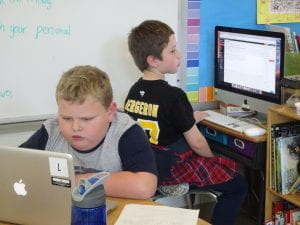 We’ve been exploring curiosity. What is curiosity? When is it a good thing and how can we grow it? When is it a strength? How can it power learning and discovery? We’ve launched an independent inquiry. The children have each chosen their own topic and are in the process of questioning, reading, researching and wondering more. Their first step was to a choose topic they each had a lot of questions about. Then they began to explore our resources – both print and online – to see if they could find information that helped us answer their questions and that sparked more. Some of the children realized they needed to change their topic and others have realized they needed to narrow and refine their topic so it became more manageable.
We’ve been exploring curiosity. What is curiosity? When is it a good thing and how can we grow it? When is it a strength? How can it power learning and discovery? We’ve launched an independent inquiry. The children have each chosen their own topic and are in the process of questioning, reading, researching and wondering more. Their first step was to a choose topic they each had a lot of questions about. Then they began to explore our resources – both print and online – to see if they could find information that helped us answer their questions and that sparked more. Some of the children realized they needed to change their topic and others have realized they needed to narrow and refine their topic so it became more manageable. We had the opportunity to plant garlic this week. Garlic is an interesting crop because you plant it in the fall and harvest it in the spring. We had a digital gram scale so the children know the weight of the clove they planted. In May we will compare it to see how it has grown. We are hoping for a successful harvest in May.
We had the opportunity to plant garlic this week. Garlic is an interesting crop because you plant it in the fall and harvest it in the spring. We had a digital gram scale so the children know the weight of the clove they planted. In May we will compare it to see how it has grown. We are hoping for a successful harvest in May.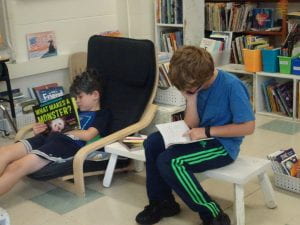 The class has been excited about the Who Am I? Scientist Project. We appreciate your support with that. The identification cards and hat blueprints are due on Tuesday, November 12. That is the day the hats and blank bags will be sent home so the children will have a full week to get that portion of the project completed.
The class has been excited about the Who Am I? Scientist Project. We appreciate your support with that. The identification cards and hat blueprints are due on Tuesday, November 12. That is the day the hats and blank bags will be sent home so the children will have a full week to get that portion of the project completed.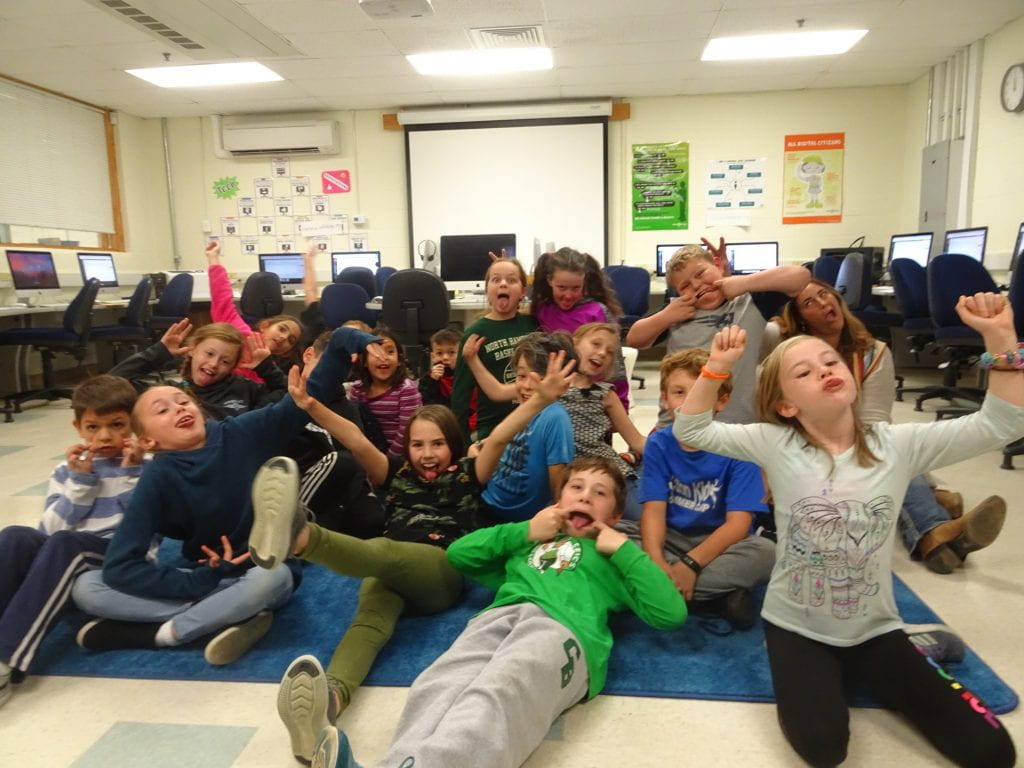
 As we begin this new inquiry project here are some tips that could help you find the information you are looking for.
As we begin this new inquiry project here are some tips that could help you find the information you are looking for.  Remember to read each section and article carefully and take notes paragraph by paragraph. Have fun on your search.
Remember to read each section and article carefully and take notes paragraph by paragraph. Have fun on your search. It’s been a busy weeks. The math stations seem to be working well, blogging continues to be exciting – thank you for all the comments and for sharing the blogging address so widely, and we’ve begun our second set of book clubs which is great, great, great.
It’s been a busy weeks. The math stations seem to be working well, blogging continues to be exciting – thank you for all the comments and for sharing the blogging address so widely, and we’ve begun our second set of book clubs which is great, great, great. This week our S.E.L. discussions have focused on the definition of bullying and how we can take care with our words. We’ve practiced being encouraging, complimentary and caring. We’ve talked about reading reactions and apologizing. We’ve read several different books, Say Something, Just Kidding, Red, and Poetreeto help us imagine different situations and to remind us of things that happen around us each day that we might make better. We’ve discussed advocating for our selves and others. We’ve begun to explore what it means to be an up-stander.
This week our S.E.L. discussions have focused on the definition of bullying and how we can take care with our words. We’ve practiced being encouraging, complimentary and caring. We’ve talked about reading reactions and apologizing. We’ve read several different books, Say Something, Just Kidding, Red, and Poetreeto help us imagine different situations and to remind us of things that happen around us each day that we might make better. We’ve discussed advocating for our selves and others. We’ve begun to explore what it means to be an up-stander. Our goal in daily problem solving is to offer the children opportunities to practice logical thinking and to find ways to use new knowledge to become more efficient over time. The children choose a strategy they can use to document their thinking and follow through to an accurate solution. This can be challenging. When you and I read the problems, we see that most of them can be solved with multiplication, but because it is still new to your children, it is not always their choice.
Our goal in daily problem solving is to offer the children opportunities to practice logical thinking and to find ways to use new knowledge to become more efficient over time. The children choose a strategy they can use to document their thinking and follow through to an accurate solution. This can be challenging. When you and I read the problems, we see that most of them can be solved with multiplication, but because it is still new to your children, it is not always their choice. We’ve spent some time understanding the ARRAY model of multiplication. The class has learned about the commutative property. We are sure that 6×7=7×6 even if we are not instantly sure of the answer. On top of that we can create an array of that amount and find a way to solve it (We know how to 7 fives and then we just need to add one more on. Or we could double 6 three times and add one more.) It is interesting to discover there are many correct ways to reach a solution.
We’ve spent some time understanding the ARRAY model of multiplication. The class has learned about the commutative property. We are sure that 6×7=7×6 even if we are not instantly sure of the answer. On top of that we can create an array of that amount and find a way to solve it (We know how to 7 fives and then we just need to add one more on. Or we could double 6 three times and add one more.) It is interesting to discover there are many correct ways to reach a solution. We are still trying to find out why Mrs. Brisbane is away from here class in Room 26. Humphrey’s been collecting clues and we have too. We’re having fun reading Mysteries According to Humphrey.
We are still trying to find out why Mrs. Brisbane is away from here class in Room 26. Humphrey’s been collecting clues and we have too. We’re having fun reading Mysteries According to Humphrey.